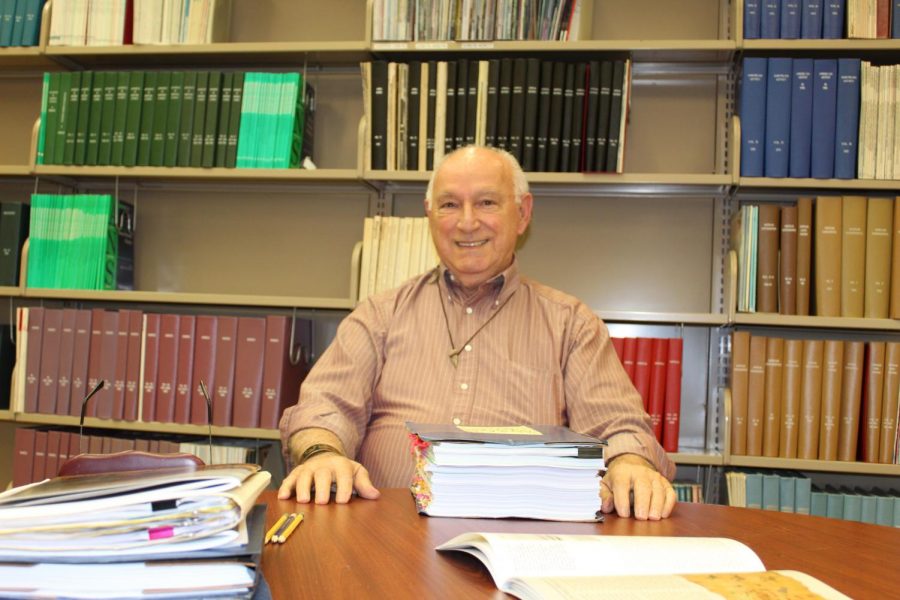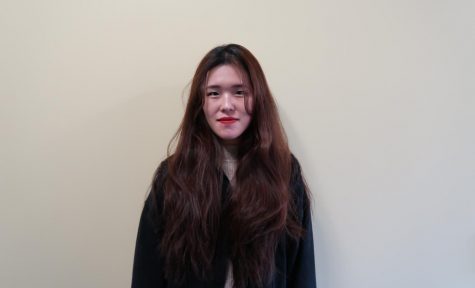Blackfeet massacre is scholar’s focus
Roger Henderson said he spent his time working on his book about the Baker Massacre in Owen Library. The pile of paper in front of him was the finished book. He said he is in the editing stage.
September 18, 2019
History is written by those with the guns and dogs, according to Roger Henderson.
Some people might not recognize this name, but if they are a frequent visitor of the Owen Library, they might have seen a man with gray hair and a little braid sitting behind a pile of paper, fully absorbed.
Henderson is a former history professor at the Penn State-Fayette campus. He worked there from 1985-2009.
Henderson said he has been a frequent visitor of the Owen Library since about five years ago.
“I am originally from Missouri, but now I live in Richland Township. I used to work at the public library downtown, where I could hook up with Penn State’s library and order books from them.
“Then I found here. There’s a lot of space where I could spread out my papers and work.”
Henderson said he taught Native American, Women and African American history when he was still a professor.
“I taught basic survey courses when I first started teaching, but then I realized that our history books tend to leave out Indians, Women and the Africans. So I opened three classes for each of them.”
He said he is working on a book about the Baker Massacre—a massacre of the Piegan Blackfeet Indians carried out by the U.S. Army in the 1870s.
According to Henderson, the Baker Massacre was also called the Piegan Expedition, led by Major Eugene Baker. Most of the victims were women, children and elderly men.
However, American records claimed that most of the people killed were young men.
Henderson said that the truth of this event has been preserved through the word of mouth, there weren’t many records from the Native American’s perspective.
“I wanted to tell the story from a different perspective, and see how they’re similar or different from our records.
“I learned about the massacre during my first trip to Montana.
“I was at the Sun Dance Ceremony, and the man who sat next to me asked about what I thought of the Baker Massacre. I’ve seen pieces of information here and there, but I didn’t know much about it.
“The man saw my face and said nothing, he just went back to drinking his soup, the woman started telling me about it.
“From the way they reacted I knew that this was something very important to them, but in our history books it wasn’t talked about much. That was when I decided to research about it.
“And I vowed to myself that someday I will let everyone hear the story,” he said.
The book that Henderson is working on is the book version of an article that he wrote for Montana: The Magazine of Western History called “The Piikuni and the U.S. Army’s Piegan Expedition” in spring 2018.
“I wrote the article first. It kind of serves as the preview of the book. It’s the same event, just more detailed.
“I have 14 crates of notes regarding the Baker Massacre at home, and one of them are all newspapers from the 1870s leading up to the event.”
He said he received a national award for this article. Besides the award, he said the best byproduct of the article was that the grandson of one of the survivors contacted him after he read the article.
“He contacted me through email and told me he would like to share his story with me.
“I’ll be going to Montana this October, and I’m excited to see him. I’ll be bringing my book with me; I hope he likes it.”
Henderson said he has finished writing the book, now he is just editing it.
“There are about 600 pages now, but a lot the pages only have a couple lines on it. So it’s probably about 300-400 pages after it’s published.”
Although Henderson started focusing on Native American history only after he became a history professor, his ties with Native Americans can be traced back to his childhood.
He said while his great grandmother was seldom brought up when he was a child, people would use derogatory terms for Native American women to refer to her.
“Oklahoma has a lot of prejudice against the Indians.
“I always mentally rejected this kind of prejudice.
“I started keeping a braid, and the last time I had a regular haircut was in 1990.
“It’s like a reminder to myself.
“It may not be in a while, but I vowed to myself to wear it until everyone is free, just like how I vowed to let everyone hear the story,” Henderson said.


